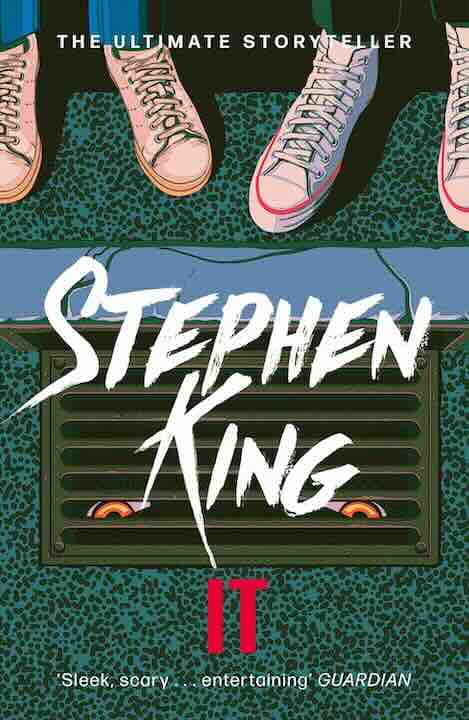Okay, let’s dive into the modern horror classic that is Stephen King’s “It” – a book that has kept readers up at night, utterly transfixed (and maybe a little traumatized) for decades now. On its surface, we’ve got the irresistible hook of a shapeshifting, malevolent entity code-named “It” that cycles through tormenting the small town of Derry, Maine across generations. But peel back the deliciously lurid layers, and you’ll find so much more – a richly-layered examination of the darkest corners of humanity, the scars left by trauma, and the vital healing power of friendship against true evil.
Plot:
The story constantly toggles between two interweaving timelines anchored around one central crew of social outcasts dubbed the “Losers Club.” In the 1950s-set chapters, King vividly renders the ragtag misfits’ battles against both the ancient, protean evil force that’s adopted the chilling disguise of Pennywise The Dancing Clown as well as the very human horrors of schoolyard bullying, abuse, and marginalization they endure.
The author paints these formative experiences of solidarity against primal evil in such texturally-rich yet emotionally-candid detail – you’ll wince recalling your own most isolating childhood traumas, yet feel the warm embrace of finding your own tribe against darkness too. King exhibits sheer mastery in contrasting that nostalgic sense of youthful stickball adventures with lurking otherworldly malignances seeming to stalk every suburban backroad and sewer grate.
Flash forward a few decades later, and those now-scattered adult Losers are summoned back by a supernatural force to fulfill a childhood blood pact and finish what they started. As they wrestle with fractured memories of the full extent of their deadly dance with the sinister Pennywise entity, King rackets up the existential dread and personal reckonings amidst a sprawling portrait of small-town rot and evil’s corrosive, multi-generational cycles.
Main Character Analysis:
While Pennywise certainly provides the malicious engine inciting all the horrific action as one of modern horror’s most disturbing villain creations, for me the novel’s richest anchors are the exquisitely-rendered members of the Losers Club ensemble banding together against it. These underdogs feel so vividly, empathetically realized on the page that you can’t help seeing threads of your own youth’s isolation and alienation in their motley makeup.
The emotional core is absolutely Bill Denbrough – our brave, eternally haunted leader rendered with such soulful strokes that I couldn’t help viscerally relating to the compounded grief, anger, and self-recrimination eating him alive following his little brother Georgie’s death. Watching both the child and adult Bill navigate those personal demons and wrestle with paralyzing guilt over not being able to protect his family emerges as one of “It’s” most grounding anchors of relatability.
But every member of the friend group is rendered with such tender nuance too. From the hypochondriac, perpetually anxious, and abused Eddie Kaspbrak to the bravado-masking-massive-insecurity of Richie Tozier, you understand on a bone-deep level the childhood loneliness, self-doubts, and trauma that welded these inseparable companions into the bravest of warriors against their town’s evil heart. Even the bully characters get their ugliness humanized in authentic psychological swerves, as if to remind evil’s insidious virality when bred through the right environment.
Writing Style:
Much like the central shapeshifting terror “It” itself, Stephen King’s writing style is atmospheric yet psychologically acute and seems to instantaneously adapt to whatever tonal register or sense of character internality he needs to make the narrative’s horrors and nostalgic wistfulness equally visceral and immersive. His cinematic eye for granular detail and mastery at toggling between rich naturalistic environments and character’s churning inner demons grounds even the most phantasmagoric set pieces in lucid, inescapable plausibility.
Simply put, King locates the existential dread and wonder lurking within the most mundane routines and seemingly unassuming locales – transporting you directly inside the fragile human realities his supernatural malevolences seem to creep up on.
Themes:
For all its masterful delivery of compulsive, page-turning supernatural horror, “It” operates as something far richer and resonant for Stephen King – a profound cross-examination of society’s deepest underbelly and the sinister inheritances we pass between generations if left willfully unconfronted.
Right from its depiction of the sunny, sleepy environs of Derry, Maine, King bores into a lurking sickness shaping its populace—a collective amnesia and cowardly complacency surrounding the town’s grimmest founding atrocities and abuses that ultimately begets the monstrous being itself. Pennywise emerges as the physical manifestation of humanity’s darkest hungers and duality between innocence and depravity unleashed through a profound lack of accountability or self-awareness.
In turn, the Losers symbolize both our indelible childhood traumas and the raw courage that must be summoned to exorcise those demons before they fatally metastasize. Their misfit solidarity in staring down the abyss becomes a rallying cry for wrestling back collective consciousness from violence’s toxic hand-me-downs. Ultimately, “It” demands the primal reckoning with evil’s insidious inheritance we all must undergo before any spiritual renewal can be sparked.
King’s interlacing of nostalgic youthful camaraderie and body-horror frights forms a dueling helix of anguished humanity and stark existential truths about the eternal war between light and shadow within our very souls – and society’s refusal to confront its personal shortcomings. For all its successful delivery of shocks and narrative pyrotechnics, “It” scorches with this profound interrogation of how our most painful formative experiences and deepest cultural toxins burrow their hooks from one generation to the next until we muster the bravery to purge them once and for all.
What People Are Saying:
Regarded as one of the seminal genre-blending achievements in modern literary horror, Stephen King’s “It” has earned rapturous critical acclaim and longevity befitting its status as a contemporary classic since its 1986 publication. Reviewers have lavished praise on King’s deft balance of visceral supernatural shocks with raw emotional authenticity in chronicling both childhood nostalgia’s fleeting beauty and the soul-rending scars left from inherited trauma.
King’s novel has also been hailed by academics and cultural critics as a vital work of 20th century American fiction given its bold interrogation of societal amnesia, cycles of violence, and toxic byproducts when communities lose their grip on ethical self-awareness.
My Personal Take:
You know, it’s wild to me that one of my most impactful and perspective-shifting reading experiences of adulthood came from cracking open a 1,000+ page, decades-old horror saga about a malevolent entity terrorizing a sleepy small town. I’ll be the first to admit harbouring some snobbish preconceptions towards Stephen King’s prolific output before finally devouring “It” on a friend’s recommendation. Something about his almost mythically populist appeal and penchant for scaring the masses made me wrongly dismiss his writing as more disposable, crowd-pleasing schlock than substantive literary merit.
But man, did this horror epic absolutely bowl me over and readjust my entire conception of what a horror narrative—or hell, any narrative—can achieve when filtered through a genuine master storyteller’s empathetic insight into the eternal human condition. On one level, yes, I was utterly transfixed by the gripping, phantasmagoric episodes of otherworldly evil slithering into Derry and the Losers’ white-knuckle quest to expel the sinister Pennywise once and for all. Those sequences pack a lurid, primal power sure to sear themselves into the darkest recesses of your subconscious for all time.
However, what left the most indelible mark on me were the exquisite brushstrokes King deploys in capturing both the nostalgic transcendence of childhood friendship and bonding over shared alienation, as well the perpetual traumas begat when we’re robbed of that redemptive innocence before time. The entire saga ultimately coheres as this profound reckoning with toxic inheritances, society’s most haunting abuses, and the raw courage demanded in confronting one’s psychological specters before any cathartic rebirth – within ourselves or the world around us – can be manifested.
Growing up myself in a fractured home and internalizing plenty of toxic societal messaging around masculinity and identity, King’s ability to render such tenderly resonant portraits of emotional scarring amidst the lurid shape-shifting mayhem struck an achingly personal chord. The exhilaration of turning pages can’t be overstated. But it was ultimately the book’s palpable wisdom about human bonds, self-knowledge, and healing’s most daunting trials that cleaved my soul in that affirming way only the most impactful art can accomplish. Less a horror novel than a hard-won battle map for embracing one’s whole self in order to conquer darkness.
Wrapping It Up:
Few works of contemporary American fiction cast as singularly dazzling and haunting a spell as Stephen King’s “It.” On one hand, it delivers an unimpeachable compendium of skin-crawling supernatural terror, breathless plotting, and shiver-inducing evil iconographies to thoroughly rattle readers to their cores. But beneath the shocks and thrills, King weaves a profound exploration of trauma’s shaping role in our lives, the dark inheritance society bestows through lack of accountability, and the deep solidarity required to confront our oldest demons once and for all.
A simultaneously exhilarating and soul-cleansing artistic accomplishment that no amount of critical dissection can dull the power of. “It” arrives as an epochal reminder of horror’s vital therapeutic purpose in confronting the evil lying dormant within us all.





